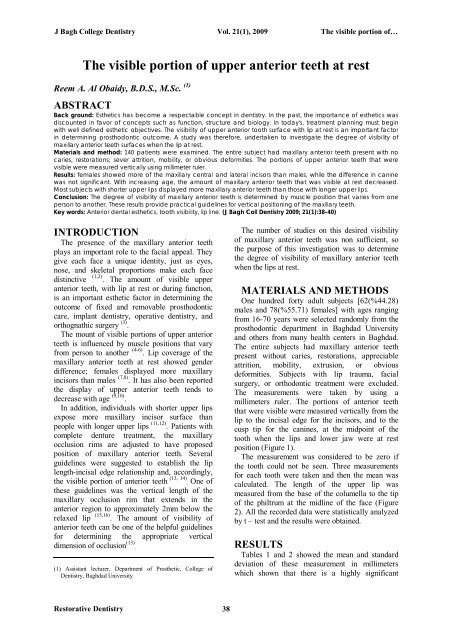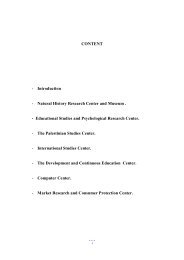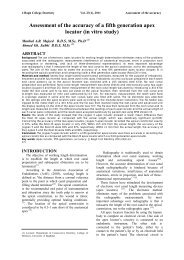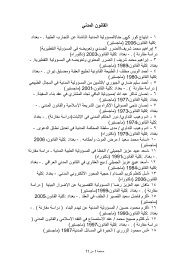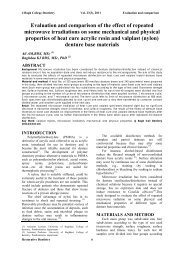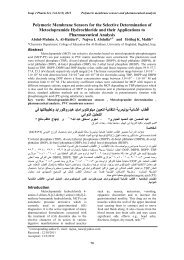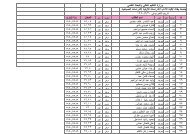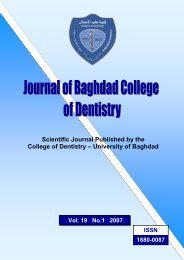Vol 21 No. 1
Vol 21 No. 1
Vol 21 No. 1
Create successful ePaper yourself
Turn your PDF publications into a flip-book with our unique Google optimized e-Paper software.
J Bagh College Dentistry <strong>Vol</strong>. <strong>21</strong>(1), 2009 The visible portion of…<br />
The visible portion of upper anterior teeth at rest<br />
Reem A. Al Obaidy, B.D.S., M.Sc. (1)<br />
ABSTRACT<br />
Back ground: Esthetics has become a respectable concept in dentistry. In the past, the importance of esthetics was<br />
discounted in favor of concepts such as function, structure and biology. In today's, treatment planning must begin<br />
with well defined esthetic objectives. The visibility of upper anterior tooth surface with lip at rest is an important factor<br />
in determining prosthodontic outcome. A study was therefore, undertaken to investigate the degree of visibility of<br />
maxillary anterior teeth surfaces when the lip at rest.<br />
Materials and method: 140 patients were examined. The entire subject had maxillary anterior teeth present with no<br />
caries, restorations; sever attrition, mobility, or obvious deformities. The portions of upper anterior teeth that were<br />
visible were measured vertically using millimeter ruler.<br />
Results: females showed more of the maxillary central and lateral incisors than males, while the difference in canine<br />
was not significant. With increasing age, the amount of maxillary anterior teeth that was visible at rest decreased.<br />
Most subjects with shorter upper lips displayed more maxillary anterior teeth than those with longer upper lips.<br />
Conclusion: The degree of visibility of maxillary anterior teeth is determined by muscle position that varies from one<br />
person to another. These results provide practical guidelines for vertical positioning of the maxillary teeth.<br />
Key words: Anterior dental esthetics, tooth visibility, lip line. (J Bagh Coll Dentistry 2009; <strong>21</strong>(1):38-40)<br />
INTRODUCTION<br />
The presence of the maxillary anterior teeth<br />
plays an important role to the facial appeal. They<br />
give each face a unique identity, just as eyes,<br />
nose, and skeletal proportions make each face<br />
distinctive (1,2) . The amount of visible upper<br />
anterior teeth, with lip at rest or during function,<br />
is an important esthetic factor in determining the<br />
outcome of fixed and removable prosthodontic<br />
care, implant dentistry, operative dentistry, and<br />
orthognathic surgery (3) .<br />
The mount of visible portions of upper anterior<br />
teeth is influenced by muscle positions that vary<br />
from person to another (4-6) . Lip coverage of the<br />
maxillary anterior teeth at rest showed gender<br />
difference; females displayed more maxillary<br />
incisors than males (7,8) . It has also been reported<br />
the display of upper anterior teeth tends to<br />
decrease with age (9,10) .<br />
In addition, individuals with shorter upper lips<br />
expose more maxillary incisor surface than<br />
people with longer upper lips (11,12) . Patients with<br />
complete denture treatment, the maxillary<br />
occlusion rims are adjusted to have proposed<br />
position of maxillary anterior teeth. Several<br />
guidelines were suggested to establish the lip<br />
length-incisal edge relationship and, accordingly,<br />
the visible portion of anterior teeth (13, 14) . One of<br />
these guidelines was the vertical length of the<br />
maxillary occlusion rim that extends in the<br />
anterior region to approximately 2mm below the<br />
relaxed lip (15,16) . The amount of visibility of<br />
anterior teeth can be one of the helpful guidelines<br />
for determining the appropriate vertical<br />
dimension of occlusion (13) .<br />
(1) Assistant lecturer, Department of Prosthetic, College of<br />
Dentistry, Baghdad University<br />
The number of studies on this desired visibility<br />
of maxillary anterior teeth was non sufficient, so<br />
the purpose of this investigation was to determine<br />
the degree of visibility of maxillary anterior teeth<br />
when the lips at rest.<br />
MATERIALS AND METHODS<br />
One hundred forty adult subjects [62(%44.28)<br />
males and 78(%55.71) females] with ages ranging<br />
from 16-70 years were selected randomly from the<br />
prosthodontic department in Baghdad University<br />
and others from many health centers in Baghdad.<br />
The entire subjects had maxillary anterior teeth<br />
present without caries, restorations, appreciable<br />
attrition, mobility, extrusion, or obvious<br />
deformities. Subjects with lip trauma, facial<br />
surgery, or orthodontic treatment were excluded.<br />
The measurements were taken by using a<br />
millimeters ruler. The portions of anterior teeth<br />
that were visible were measured vertically from the<br />
lip to the incisal edge for the incisors, and to the<br />
cusp tip for the canines, at the midpoint of the<br />
tooth when the lips and lower jaw were at rest<br />
position (Figure 1).<br />
The measurement was considered to be zero if<br />
the tooth could not be seen. Three measurements<br />
for each tooth were taken and then the mean was<br />
calculated. The length of the upper lip was<br />
measured from the base of the columella to the tip<br />
of the philtrum at the midline of the face (Figure<br />
2). All the recorded data were statistically analyzed<br />
by t – test and the results were obtained.<br />
RESULTS<br />
Tables 1 and 2 showed the mean and standard<br />
deviation of these measurement in millimeters<br />
which shown that there is a highly significant<br />
Restorative Dentistry 38


